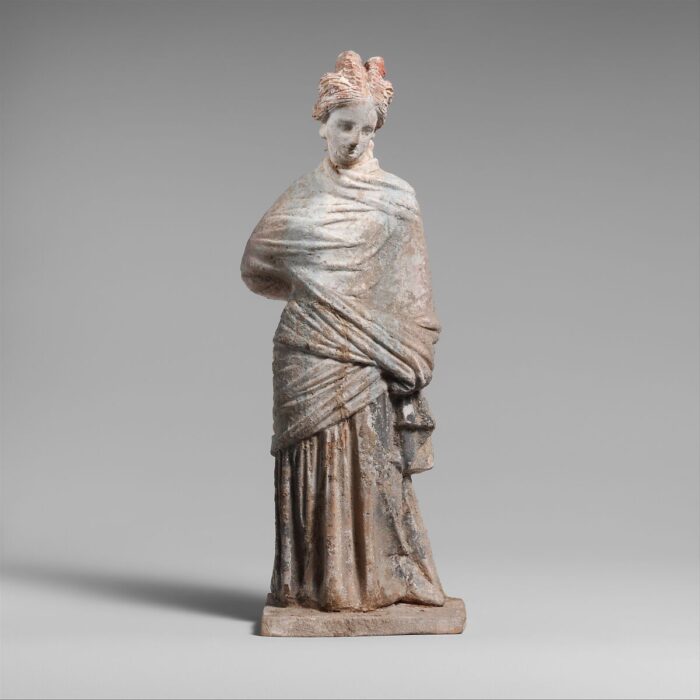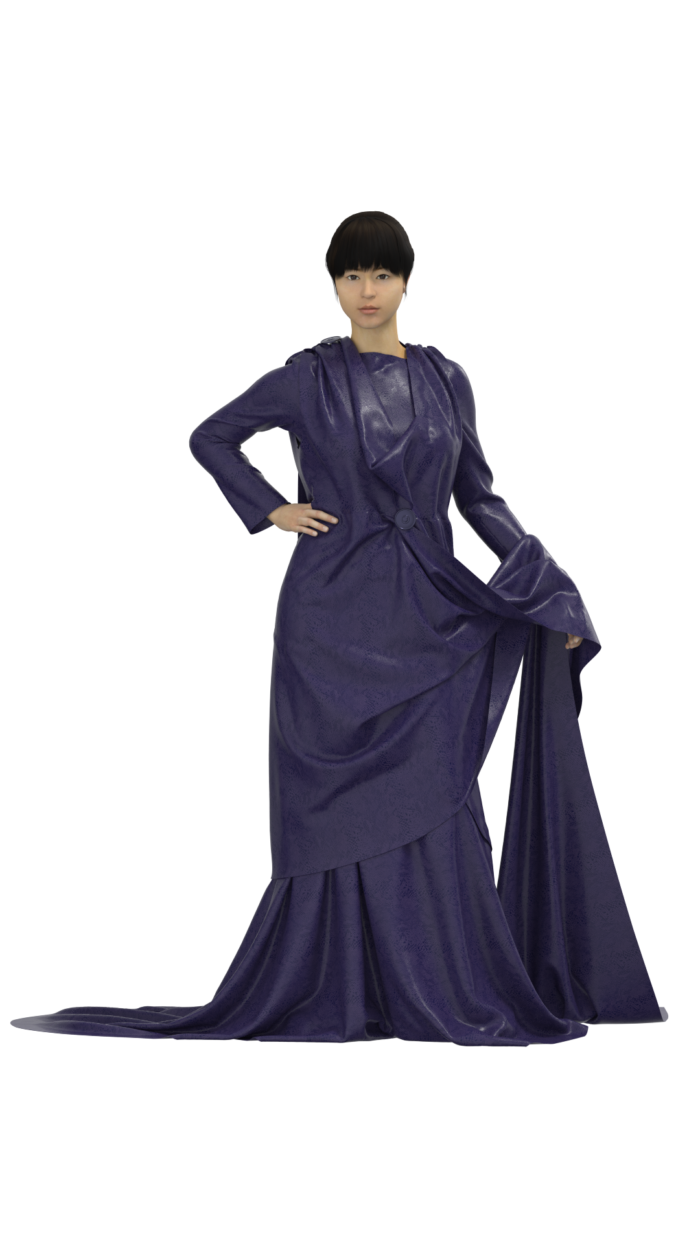In 1908, the Italian seamstress, political activist and writer Rosa Genoni (1864-1954) designed a dress inspired by the Tanagra statuettes. This dress became one of the most important re-interpretations and re-castings of women’s fashion in classical antiquity. The late nineteenth century discovery of the Greek statuettes that she most likely was able to admire at the Louvre Museum sparked not only Genoni’s imagination, but most importantly also contributed to a rethinking of the relationship between dress, gender, identity and performance in public and social spaces. Rosa Genoni first designed the dress for herself and then in another version with a different fabric and accessories for the well-known diva Lyda Borelli, who became a testimonial for the new design. Genoni wore a more casual version of the Tanagra dress when she delivered a speech on fashion and feminism at the First Italian Congress of Women in Rome in April 1908. The Tanagra dress became the embodiment of her ideas of femininity and agency but also established a line of continuity with the past. The reframing of the past engendered new models of femininity and beauty intimately connected to the intellectual and political spheres.
This is the topic of the lecture “Rosa Genoni’s Tanagra Dress Reframed: A Story of Fashion, Performance, Feminism” by Eugenia Paulicelli, a scholar of Rosa Genoni. The lecture will recount this story, as well as the contemporary re-framing of Genoni’s Tanagra dress that has brought it to life and with it has illustrated a process of history in the making.
The lecture on Genoni will be delivered on March 21st, 2024, at the “Michael C. Carlos Museum,” Emory University, in Atlanta and in conjunction with the exhibition, Recasting Antiquity: Whistler, Tanagra, and the Female Form.
See the CUNY TV’s “Urban U” September 2023 episode below that featured her work.
Please see below the Capstone thesis on the Tanagra dress by Christina Trupiano for her MA in Fashion Studies/Master of Arts in Liberal Studies (MALS) at the CUNY Graduate Center (Spring 2024) and directed by Eugenia Paulicelli.
Tanagra Dress Reimagined



Process of the Tanagra Dress Reimagining



Figure 4.2: Middle photo is of the actual two forms used to begin conceptualizing Tanagra Dress Drape, and is pictured for purpose of showing scale. Small scales are often used to begin conceptualizing a garment without wasting resources before structure is determined.
Figure 4.3:Far right photo was also taken June 3,2017 on standard size form.
Through trial and error, I went back and forth between small and large form trying to decipher the movement and drape of the garment to recreate.

Tanagra on Display

Tanagra in Motion
The Technical Design of the New Tanagra Dress



Tanagra in 3D
3D Tanagra Reimagining Continued
Figure 12,13, 14, and 15 : To continue the reimagining process, feasible and environmentally sound, the Tanagra dress was rendered using CLO 3D several times, to utilize new fabrications and prints, and to add a unique perspective to the existing design. From standard to unusual elements, playing with proportion and space, organic vs. the abstract, and floral vs. modern, the viewer can appreciate the overall design elements of the Tanagra Dress’s dynamic nature, both in wearability and in visual effect.




WEBSITE BIBLIOGRAPHY
Figure: 1, Terracotta Statuette-“Terracotta Draped Woman: Greek, Boeotian: Hellenistic.” The Metropolitan Museum of Art, www.metmuseum.org/art/collection/search/247882. Accessed 19 Dec. 2023.
Figure: 2, Lydia Borelli -Radiogold. “Donne Nella Grande Guerra: Il Caso Di Rosa Genoni, Sarta per La Pace.” RadioGold.It, 6 Mar. 2015, radiogold.it/news-alessandria/eventi/24057-donne-grande-guerra-caso-rosa-genoni-sarta-pace/.
Figure: 3, Tanagra Dress on Mannequinn -“Tanagra.” Home -, thefabricofcultures.com/foc-object/tanagra/. Accessed 19 Dec. 2023.
Figure: 4.1: Trupiano, Christina. Photograph of Drape on Mini Scale Form. 3 June 2017. Authors Personal Collection
Figure: 4.2, Trupiano, Christina. Photograph of Two Forms for Scale. 19 November 2023. Authors Personal Collection
Figure: 4.3, Trupiano, Christina. Photograph Self Draping Restaged. 19 November 2023. Authors Personal Collection
Figure:6, 13, I. I. (October. “The Art of Making & the Made in Italy.” iItaly.Org, www.iitaly.org/magazine/focus/art-culture/article/art-making-made-in-italy.Accessed 19 Dec. 2023.
Figure: 7, “Dress in Motion The Tanagra Dress Reframed.” YouTube, 17 July 2023, https://youtu.be/x84p945neYg?si=gtPd9djsVw71Qtg7. Accessed 19 Dec. 2023.
Figure 8, Technical CAD of Tanagra Dress Created on Adobe Illustrator. 11 November 2023.
Figure: 9, Pattern photo inspired by the Statue of Samotracia, Paulicelli, Eugenia. Rosa Genoni. Fashion Is a Serious Business. Milan Expo 1906 and the Great War. Milan, Deleyva, 2015.
Figure:10, Digital Pattern of Tanagra Dress Wrap created on Gerber Accumark V15. 7 November 2023.
Figure: 11, CLO 3D turntable view, Trupiano, Christina. “Tanagra in 3d.” Vimeo Interactive Video Experience Platform, vimeo.com/894647946?share=copy. Accessed 15 Dec. 2023.
Figure:13,14 and 15, CLO 3D Renders of Tanagra Dress, created on CLO 3D. 14 December 2023.
